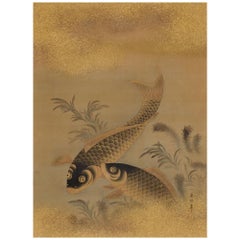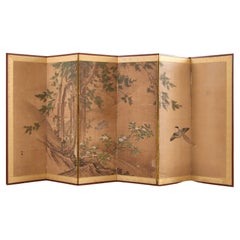Iwase Hirotaka Paintings and Screens
1808-1877
Iwase Hirotaka was originally a Kyoto based Ukiyo-e artist known as Hishikawa Kiyoharu. At the age of 26 or 27, he moved to Wakayama, changed his name, and began studying Yamato-e with Tanaka Totsugen and Ukita Ikkei. Totsugen and Ikkei were leaders of the Fukko Yamato-e school and were connected to a political movement that sought to revive the power of the Emperor. A diverse and accomplished artist, Hirotaka eventually turned to literati painting, which he learned from Tetsuo Somon.
to
1
1
1
1
1
1
1
1
1
1
1
30
4
3
3
Creator: Iwase Hirotaka
Japanese Painting, Hanging Scroll, Mid 19th Century, Koi and Water Plants
By Iwase Hirotaka
Located in Kyoto, JP
Iwase Hirotaka (1808-1877)
Koi and Water Plants
Hanging scroll, ink, color, gold wash and gold flecks on silk
Inscription: Hirotaka
Seal: Ille...
Category
1860s Japanese Edo Antique Iwase Hirotaka Paintings and Screens
Materials
Silk
Related Items
19th Century Japanese Edo Six Panel Kano School Landscape Screen
Located in Rio Vista, CA
Late Edo period 19th century Japanese six-panel landscape screen featuring a cypress tree over a flowering hibiscus with a pair of hototogisu birds. Kano school painted with ink and ...
Category
19th Century Japanese Edo Antique Iwase Hirotaka Paintings and Screens
Materials
Silk, Wood, Paper
Chinese Patriarch and Matriarch Ancestral Scroll Painting
Located in Rio Vista, CA
Magnificent Chinese scroll ancestor painting showing patriarch and matriarch of a high ranking status civil official. This unusual scroll depicts the dignitary couple seated below a ...
Category
Early 20th Century Chinese Qing Iwase Hirotaka Paintings and Screens
Materials
Paper, Wood, Paint
Chinese Hanging Scroll Painting of Camellias Signed Dated
Located in Rio Vista, CA
Seasonal autumn Chinese hanging scroll painting depicting colorful Camellias with a calligraphy signature and date. Crafted on hand-made mulberry paper wi...
Category
20th Century Chinese Qing Iwase Hirotaka Paintings and Screens
Materials
Wood, Paper
Chinese Hanging Scroll of Prunus Branches, circa 1850
Located in Chicago, IL
Chinese scholars used natural imagery and scenery to aid in contemplation within the walls of their studios. The complex beauty inherent to landscapes and natural forms inspired clea...
Category
Mid-19th Century Chinese Qing Antique Iwase Hirotaka Paintings and Screens
Materials
Paper
Chinese Qing Dynasty 19th Century Official's Wife Painting on Linen Canvas
Located in Yonkers, NY
A Chinese Qing Dynasty period framed painting from the 19th century of an official's wife with bird-adorned buzi, painted on a linen canvas. Created in the North-Eastern province of Shanxi during the Qing dynasty, this 19th century painting showcases a frontal depiction of an official's wife recognizable thanks to the bird-themed rank badge sitting on an elegant armchair with scrolling arms and carved apron. Wearing a red robe and topped with an ornate headdress, the figure is highlighted with gold foil accents and stands out beautifully on a linen canvas. The print size is 17.5"W x 41.5"H. These paintings traditionally come from Shanxi province which was home to many of the wealthy merchant families associated with the imperial court during the Qing dynasty. Set inside a custom made frame, this 19th century Qing Dynasty official's wife painting...
Category
19th Century Chinese Antique Iwase Hirotaka Paintings and Screens
Materials
Canvas, Plexiglass, Wood
Early 19th Century Japanese Six-Panel Screen, Tropical Garden
Located in Hudson, NY
With a banana leaf palm on the left, at water's edge with geese. Perhaps a scene from the southern islands. Mineral pigments on mulberry paper with gold leaf and a silk brocade border.
Category
Early 19th Century Japanese Antique Iwase Hirotaka Paintings and Screens
Materials
Gold Leaf
Large Framed Japanese Buddhist Amida Temple Hall Painting, Mid-19th Century
Located in Austin, TX
A large and incredible Japanese painting of a Buddhist temple hall with Amida Nyorai, late Edo or early Meiji period, mid-19th century, Japan. Mounted wit...
Category
Mid-19th Century Japanese Meiji Antique Iwase Hirotaka Paintings and Screens
Materials
Wood, Paint, Brocade, Silk, Acrylic
H 76.25 in W 50 in D 3.25 in
Japanese Hanging Scroll, Late 19th Century
Located in New York, NY
A Japanese hanging scroll or Kakejiku, circa 1890, depicting bamboo grass and a rabbit, framed by top and bottom ribbons of brocade silk.
In ...
Category
1890s Japanese Meiji Antique Iwase Hirotaka Paintings and Screens
Materials
Silk, Paper
Large Framed Indian 19th Century Painting of Guanyin Sitting on a Dragon
Located in Yonkers, NY
An antique Indian painting from the 19th century depicting Guanyin the Bodhisattva of Compassion sitting on a dragon. Created in India during the 19th century, this large painting features Guanyin the Bodhisattva of Compassion, sitting on the head of a dragon. Her right foot on a lotus flower, Guanyin wears an ornate headdress and elegant clothes. The painting itself measures 27.5"W x 53.5" H and has been set inside a custom frame. With its vivid colors and elegant subject, this 19th century Indian painting...
Category
19th Century Indian Antique Iwase Hirotaka Paintings and Screens
Materials
Fabric, Plexiglass, Paper
H 66.25 in W 35.25 in D 2 in
Japanese Six Panel Screen with Hotei, Edo Period, Early 19th Century
Located in Austin, TX
A delightful Japanese six panel painted paper screen featuring the beloved figure Hotei, Edo Period, early 19th century.
Hotei, called Budai in China, and known as the Laughing Buddha or Fat Buddha in the West, is considered to be an emanation of Maitreya, the Buddha of the Future.
In Japan, he also holds a special place as one of the Seven Lucky Gods, being the god of fortune, and protector of children.
He is always portrayed as a mirthful and corpulent man, dressed in loose robes that show off his round belly. He carries a sack with him, said to be filled with treasure. As the protector of children, he is often portrayed with them playing on or around him, as he is here. The children portrayed in this screen are dressed in Chinese style clothing...
Category
Early 19th Century Japanese Edo Antique Iwase Hirotaka Paintings and Screens
Materials
Silk, Paper
Set of Four Japanese Silk Hanging Scrolls Screens C.1920
Located in London, GB
A stunning set of four Japanese silk mounted vertical hanging scrolls.
Dating from C.1920 Taisho Period.
The watercolour and ink on silk depicts a larg...
Category
1920s Japanese Japonisme Vintage Iwase Hirotaka Paintings and Screens
Materials
Silk
Set of 6 Large Kakemonos Japanese Mythology, 19th Century Japan circa 1800 Edo
Located in Beuzevillette, FR
Beautiful set of 6 large kakemonos from 19th century Japanese mythology.
Paper support with a canvas pasted on the paper
Wonderful set that is part of Japan's history and beliefs
When not hung, the Kakemonos are rolled up.
circa 1800 - Japan - Edo Period
A kakemono translates as "object to hang". In Japan this refers to a painting or calligraphy, most often done on silk or paper framed in a scroll that was intended to be hung on walls or in public lighting. This particular form, which allows them to be in a roll, dates back to the Tang dynasty in China (this would be related to the copying and preservation of ancient Buddhist texts). A Kami is a deity or spirit worshipped in the Shinto religion. A Yokai is a spirit, ghost, demon, or strange apparition from the creatures of Japanese folklore.
Each of these kakemonos represents a unique story:
- A kami, a Japanese deity, is shown painting a rainbow. Indeed, he performs the action with his right hand while his left hand holds a kind of basket with three pots of paint. This kami has a rather closed attitude. He is standing in a dark and tormented sky. Below this figure, 8 villagers are dressed in traditional Japanese clothes. Their faces are softened. They are not afraid of the elements made by the kami above their heads.
- A character with an unreal look is holding a kind of jar with his two hands, which he spills on human figures above. This being is floating in the air, probably a character from mythology, perhaps Susanoo. Underneath, villagers on umbrellas. They are trying to protect themselves as best they can from what is falling on them. One of them is carrying baskets with fish on her shoulders. A character in the background is thrown forward and falls.
- On this kakemono, the god Raijin, dressed in a white and blue outfit, strikes the sky with his two drum hammers to create lightning and its thunderous sound. Surrounded by Tomoe and a long red scarf, Raijin, enraged and with dishevelled hair, creates a dark and violent storm. The villagers seem frightened by this meteorological phenomenon. One of the villagers can be seen fainting in the arms of a man. This scene may seem chaotic, but Japanese legend tells us that once a field is struck by lightning, the harvest is good.
- On this kakemono, we see an unreal-looking figure holding a fan, as if he were sweeping away the bad weather, or simply producing gusts of wind. He is probably the kami of wind and air, Shina tsu-hiko. The figures below him seem surprised by so much wind. An umbrella flies away on the left, the women hold their hair and scarf, the clothes are caught in the power of the wind, there is even a woman on the ground on the bottom left.
- This Kakemono represents a short moment. This Raiju is a yokai (ghost spirit...
Category
19th Century Japanese Edo Antique Iwase Hirotaka Paintings and Screens
Materials
Paper
H 63.78 in W 20.48 in D 0.04 in
Iwase Hirotaka paintings and screens for sale on 1stDibs.
Iwase Hirotaka paintings and screens are available for sale on 1stDibs. These distinctive items are frequently made of silk and are designed with extraordinary care. There are many options to choose from in our collection of Iwase Hirotaka paintings and screens, although brown editions of this piece are particularly popular. If you’re looking for additional options, many customers also consider paintings and screens by and Japanese Studio. Prices for Iwase Hirotaka paintings and screens can differ depending upon size, time period and other attributes — on 1stDibs, these items begin at $6,500 and can go as high as $6,500, while a piece like these, on average, fetch $6,500.


